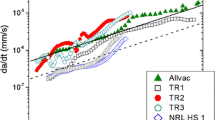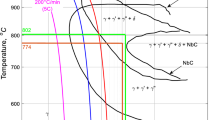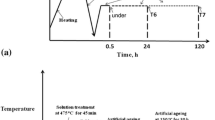Abstract
The hydrogen-environment embrittlement (HEE)-controlled stage II crack growth rate of AA 7050 (6.09 wt pct Zn, 2.14 wt pct Mg, and 2.19 wt pct Cu) was investigated as a function of temper and alloyed copper level in a humid air environment at various temperatures. Three tempers representing the underaged (UA), peak-aged (PA), and overaged (OA) conditions were tested in 90 pct relative humidity (RH) air at temperatures between 25 °C and 90 °C. At all test temperatures, an increased degree of aging (from UA to OA) produced slower stage II crack growth rates. The stage II crack growth rate of each alloy and temper displayed an Arrhenius-type temperature dependence, with activation energies between 58 and 99 kJ/mol. For both the normal-copper and low-copper alloys, the fracture path was predominately intergranular at all test temperatures (25 °C to 90 °C) in each temper investigated.
Comparison of the stage II HEE crack growth rates for normal- (2.19 wt pct) and low- (0.06 wt pct) copper alloys in the peak PA aged and OA tempers showed a beneficial effect of copper additions on the stage II crack growth rate in humid air. In the 2.19 wt pct copper alloy, the significant decrease (∼10 times at 25 °C) in the stage II crack growth rate upon overaging is attributed to an increase in the apparent activation energy for crack growth. In the 0.06 wt pct copper alloy, overaging did not increase the activation energy for crack growth but did lower the pre-exponential factor (v 0), resulting in a modest (∼2.5 times at 25 °C) decrease in the crack growth rate. These results indicate that alloyed copper and thermal aging affect the kinetic factors that govern stage II HEE crack growth rates. The OA, copper-bearing alloys are not intrinsically immune to hydrogen-environment-assisted cracking, but are more resistant due to an increased apparent activation energy for stage II crack growth.
Similar content being viewed by others

References
M.V. Hyatt and M.O. Speidel: “Stress-Corrosion Cracking of High-Strength Aluminum Alloys,” Report No. D6-24840, Boeing, Seattle, WA, 1970.
M.O. Speidel: in Hydrogen Embrittlement and Stress Corrosion Cracking, Gibala and Hehemann, eds., ASM, Metals Park, OH, 1984, pp. 271–96.
F.E. Watkinson and J.C. Scully: Corr. Sci., 1971, vol. 11, pp. 179–82.
L. Christodoulou and H.M. Flower: Acta Metall., 1980, vol. 28, pp. 481–87.
C.D.S. Tuck: Metall. Trans. A, 1985, vol. 16A, pp. 1503–14.
G.M. Scamans, R. Alani, and P.R. Swann: Corr. Sci., 1976, vol. 16, pp. 443–59.
G.M. Scamans: Aluminium, 1982, vol. 58, pp. 332–34.
G.H. Koch: Corrosion, 1979, vol. 35, pp. 73–78.
R.M. Vennett: Trans. ASM, 1969, vol. 62, p. 1007.
R.P. Wei: in Hydrogen Effects in Metals, I.M. Bernstein and A.W. Thompson, eds., TMS-AIME, Moran, WY, 1980, p. 677.
L. Christodoulou: Ph.D. Thesis, Imperial College of Science and Technology, London, 1980.
R.E. Ricker and D.J. Duquette: Metall. Trans. A, 1988, vol. 19A, pp. 1775–83.
D.R. Lide, ed., CRC Handbook of Chemistry and Physics, CRC Press, Boca Raton, FL, 1991.
G.A. Young: Ph.D. Thesis, University of Virginia, Charlottesville, VA, 1999.
T. Do, S.J. Splinter, C. Chen, and N.S. McIntyre: Surf. Sci., 1997, vol. 397 (1–3), pp. 192–98.
H.H. Uhlig: Corrosion and Corrosion Control, 3rd ed, John Wiley & Sons, New York, NY, 1985.
L.M. Young, G.A. Young, J.R. Scully, and R.P. Gangloff: Lightweight Alloys for Aerospace Applications IV, TMS, Orlando, FL, 1997.
G.L. Lewis: Thermodynamics, McGraw-Hill, New York, NY, 1961, pp. 90–114.
C.F. Shih: J. Mech. Phys. Sol., 1981, vol. 29 (4), pp. 305–26.
P. Marcus and J. Oudar: in Corrosion Mechanisms in Theory and Practice, Corrosion Technology, P.A. Schweitzer, eds., Marcel Dekker, Inc., New York, NY, 1995.
J. Albrecht, A.W. Thompson, and I.M. Bernstein: Metall. Trans. A, 1979, vol. 10A, pp. 1759–66.
J. Albrecht, I.M. Bernstein, and A.W. Thompson: Metall. Trans. A, 1982, vol. 13A, pp. 811–20.
D.A. Hardwick, A.W. Thompson, and I.M. Bernstein: Metall. Trans. A, 1983, vol. 14A, pp. 2517–26.
D.A. Hardwick, A.W. Thompson, and I.M. Bernstein: Corr. Sci., 1988, vol. 28 (12), pp. 1127–37.
P. Guyot and L. Cottignies: Acta Mater., 1996, vol. 44 (10), pp. 4161–67.
F.S. Lin and E.A. Starke: Mater. Sci. Eng., 1979, vol. 39, pp. 27–41.
F.S. Lin and J.E.A. Starke: Mater. Sci. Eng., 1980, vol. 43, pp. 65–76.
T.H. Sanders and E.A. Starke: Metall. Trans. A, 1976, vol. 7A, pp. 1407–18.
J.T. Staley: Metall. Trans., 1974, vol. 5, pp. 929–32.
A. Bigot et al.: Mater. Sci. Forum, 1996, vols. 217–222, pp. 695–700.
B.V.N. Rao: Metall. Trans. A, 1981, vol. 12A, pp. 1356–59.
K. Rajan, W. Wallace, and J.C. Beddoes: J. Mater. Sci., 1982, vol. 17, pp. 2817–24.
G.M. Scamans, N.J.H. Holroyd, and C.D.S. Tuck: Corr. Sci., 1987, vol. 47 (4), pp. 329–47.
J.R. Pickens, T.J. Langan, and J.A.S. Green: in Environment Sensitive Fracture of Metals and Alloys, United States Navy, Washington, DC, 1987.
W. Hepples, M.R. Jarrett, J.S. Crompton, and N.J.H. Holroyd: in Environment-Induced Cracking of Metals, R.P. Gangloff and M.B. Ives, eds., ASM/NACE/TMS, Kohler, WI, 1988, pp. 383–87.
J.M. Chen: Metall. Trans. A, 1977, vol. 8A, pp. 1935–40.
C.R. Shastry and G. Judd: Metall. Trans., 1972, vol. 3, pp. 779–82.
N.J.H. Holroyd: in Environment-Induced Cracking of Metals, R.P. Gangloff and M.B. Ives, eds., ASM/NACE/TMS, Kohler, WI, 1988, pp. 311–45.
J.T. Staley: “History of Wrought Aluminum Alloy Development,” Report No. 56-86-AS1, Alcoa, Alcoa Center, PA, 1986.
J.T. Staley, S.C. Byrne, E.L. Colvin, and K.P. Kinnear: Mater. Sci. Forum, 1996, vols. 217–222, pp. 1587–92.
B. Sarkar, M. Marek, and E.A. Starke: Metall. Trans. A, 1981, vol. 12A, pp. 1939–43.
E.A. Starke: in Alloying, J.L. Walter, M.R. Jackson, and C.T. Sims, eds., ASM INTERNATIONAL, Metals Park, OH, 1988, pp. 165–97.
E.A. Starke: in Aluminum Alloys—Contemporary Research and Applications, A.K. Vasudevan and R.D. Doherty, eds., Academic Press, New York, NY, 1989, pp. 35–63.
J.E. Hatch: Aluminum Properties and Physical Metallurgy, ASM, Metals Park, OH, 1984.
N.Q. Chinh et al.: Z. Metallkd., 1997, vol. 88 (8), pp. 607–611.
R.J. Livak and J.M. Papazian: Scripta Metall., 1984, vol. 18, pp. 483–88.
S. Fujikawa, T. Hara, A. Ishida, and K. Hirano: Thermochimica Acta, 1985, vol. 85, pp. 171–74.
M.O. Speidel: Metall. Trans. A, 1975, vol. 6A, pp. 631–51.
P. Doig, P.E.J. Flewitt, and J.E. Edingtion: Corrosion, 1977, vol. 22 (6), pp. 217–21.
J. Busby, J.F. Cleave, and R.L. Cudd: J. Inst. Met., 1971, vol. 99, pp. 41–49.
T.J. Langan et al.: Corrosion, 1988, vol. 44 (3), pp. 165–69.
R. Alani and P.R. Swann: Br. Corr. J., 1975, vol. 12 (2), pp. 80–85.
L. Christodoulou and H.M. Flower: in Hydrogen Effects in Metals, I.M. Bernstein and A.W. Thompson, eds., TMS, Warrendale, PA, 1980, pp. 493–50.
G.M. Scamans: J. Mater. Sci., 1978, vol. 13, pp. 27–36.
Light Metals 1998, P.N. Anyalebechi, ed., TMS, Warrendale, PA, 1998, pp. 827–42.
G.W. Lorimer: in Precipitation Processes in Solids, K.C. Russell and H.I. Aaronson, eds., TMS-AIME, Niagara Falls, NY, 1976, pp. 87–119.
A. Cziraki, B. Fogarassy, and I. Gerocs: in Light Materials for Transportation Systems, N.J. Kim, ed., TMS, Kyongju, Korea, 1993, pp. 391–405.
A.J. Morris, R.F. Robey, P.D. Couch, and E. Delos Rios: Mater. Sci. Forum, 1997, vol. 242, pp. 181–86.
M. Warmuzek: Mater. Sci. Forum, 1996, vols. 215–216, pp. 243–50.
D.J. Strawbridge, W. Hume-Rothery, and A.T. Little: J. Inst. Met., 1948, vol. 74, pp. 191–225.
E.A. Starke: Mater. Sci. Eng., 1977, vol. 29, pp. 99–115.
E.L. Colvin: Personal communication, Aluminum Company of America, Alcoa Center, PA, 1997.
R.D. Kane: “Making and Using Precrack Double Bean Stress Corrosion Specimens,” Report ASTM G01.06, ASTM, Houston, TX, 1998.
M.S. Domack: in Environmentally Assisted Cracking: Science & Engineering, “ASTM STP 1049,” W.B. Lisagor, T.W. Crooker, and B.N. Leis, eds., ASTM, Philadelphia, PA, 1990, pp. 391–409.
M.O. Speidel: in Theory of Stress Corrosion Cracking in Alloys, J.C. Scully, ed., NATO, Brussels, Belgium, 1971, pp. 289–344.
G.M. Scamans: Metall. Trans. A, 1980, vol. 11A, pp. 846–50.
K.N. Akhurst and T.J. Baker: Metall. Trans. A, 1981, vol. 12A, pp. 1059–70.
P.N. Anyalebechi: Scripta Metall., 1995, vol. 33 (8), pp. 1209–16.
P.N. Anyalebechi: Scripta Mater., 1996, vol. 34 (4), pp. 513–17.
F. Sarioglu, P. Abachi, and M. Doruk: J. Mater. Sci., 1993, vol. 28, pp. 1430–34.
G.E. Dieter: Mechanical Metallurgy, McGraw-Hill, New York, NY, 1986, p. 751.
P. Shewmon: Diffusion in Solids, TMS, Warrendale, PA, 1989, p. 246.
L.M. Young and R.P. Gangloff: unpublished research, The University of Virginia, Charlottesville, VA, 1997.
H. Vogt and M.O. Speidel: Corr. Sci., 1998, vol. 40 (2–3), pp. 251–70.
S.M. Lee, S.I. Pyun, and Y.G. Chun: Metall. Trans. A, 1991, vol. 22A, pp. 2407–14.
J.R. Scully, G.A. Young, Jr., and S.W. Smith: Materials Science Forum, 2000, 331–337, pp. 1583–1600.
A. Turnbull: in Environmentally Assisted Cracking, ASTM STP 1401, R.D. Kane, ed., ASTM, Philadelphia, PA, 2000, p. 23.
W.W. Gerberich, T. Livine, X.-F. Chen, and M. Kaczoroski: Metall. Trans. A, 1988, vol. 19A, pp. 1319–34.
P.S. Lam, R.L. Sindelar, and H.B. Peacock: “Vapor Corrosion of Al Cladding Alloys and Al-Uranium Fuel Materials in Storage Environments,” Report No. WSRC-TR-97-0120, Westinghouse Savannah River, SC, 1997.
Author information
Authors and Affiliations
Rights and permissions
About this article
Cite this article
Young, G.A., Scully, J.R. The effects of test temperature, temper, and alloyed copper on the hydrogen-controlled crack growth rate of an Al-Zn-Mg-(Cu) alloy. Metall Mater Trans A 33, 1167–1181 (2002). https://doi.org/10.1007/s11661-002-0218-y
Received:
Issue Date:
DOI: https://doi.org/10.1007/s11661-002-0218-y



